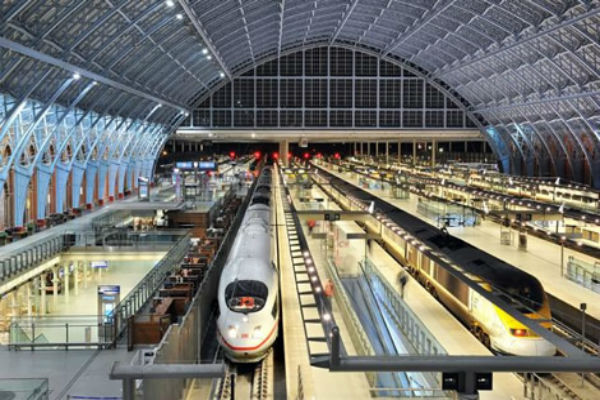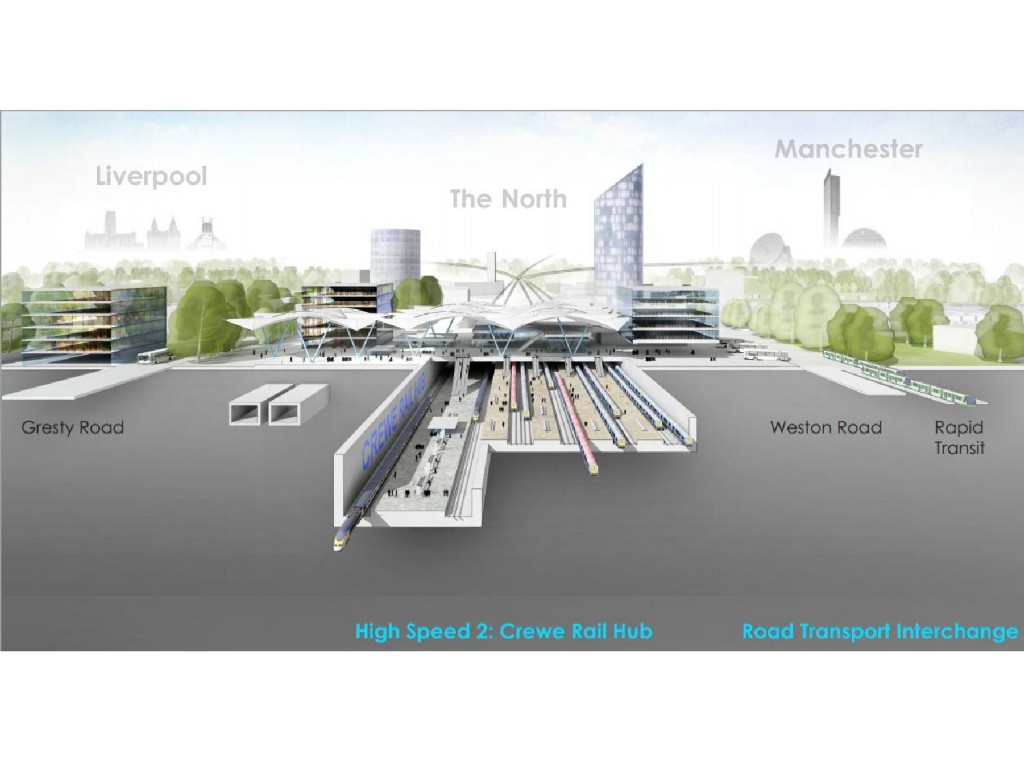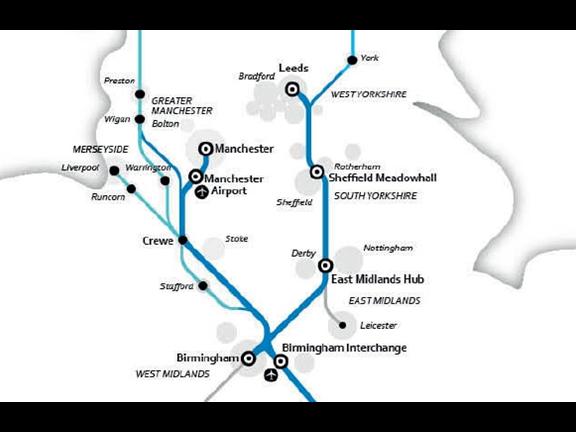High Speed Rail HS2 – good for Liverpool?

Deutsche Bahn ICE and Eurostar on HS1 high speed rail platforms at London St. Pancras – HS2 services will eventually head north.
HS2 high speed rail is a mixed blessing for Liverpool.
The HS2 High Speed Rail route north of the London to Birmingham section was announced on Jan 28th 2013.
HS2 will eventually halve journey times to the UK capital from Manchester and Leeds, to 1hr 8mins, with Liverpool-London journeys improving from 2hrs 7 mins to 1hr 36 mins, 25% faster than now.
HS2 will make Liverpool’s London rail link a full half an hour faster than now. But HS2 also downgrades relative journey times from their current parity with Liverpool’s neighbour Manchester, to being 50% slower.
So on the round trip, Manchester high speed rail services will be faster than Liverpool’s by an entire hour, leaving Liverpool’s relative position apparently weakened.
Still, the rail experts I have spoken to believe this disparity can be closed to an acceptable level (defined as half an hour slower on the round trip) by relatively modest improvements on the existing approach to Liverpool – and these can happen well before HS2 is finished c.2030.
My contacts have warmly welcomed certain detailed aspects of the line’s structure, including routing it via Crewe, the triangular junction arrangement east of Lymm, and the link to the existing West Coast Main Line at Golbourne near Wigan. These will help tie Liverpool and Manchester to Scotland as well as London.

- Crewe is a360 degree junction, with rail links in all directions. These include Dublin via Holyhead and Chester; Liverpool, Manchester and Scotland to the north; Birmingham, Stoke and the Black Country; and a sub 60 minute journey time to London with HS2.
HS2 High Speed Rail Northern Route Plans:
- The western arm of the Y, to Liverpool and Manchester via Crewe: https://www.gov.uk/government/uploads/system/uploads/attachment_data/file/69037/hs2-msg-wm0-zz-dr-rt-40014.pdf
- The eastern arm, past Nottingham, Derby and Sheffield to Leeds: https://www.gov.uk/government/uploads/system/uploads/attachment_data/file/68988/hs2-arp-000-dr-rt-55001_3-0.pdf
- The Manchester section, with its Airport Interchange and long tunnel in from the suburbs: https://www.gov.uk/government/uploads/system/uploads/attachment_data/file/69074/hs2-msg-ma0-zz-dr-rt-72801.pdf
Liverpool gets a true high speed rail service as far as Crewe – the run in will switch to the existing ‘classic’ West Coast Mainline via Runcorn for the last 35 miles. This is projected to make the Liverpool-London trip 30 minutes faster than at present, but leave us 30 minutes behind Manchester on completion (because Manchester’s dedicated HS2 line improves journey times by a full hour).
HS2 High Speed rail leaves Liverpool an hour behind Manchester on the return trip
However, there is already significant short term scope for cutting at least 10 minutes each way from the 41 minute ‘classic rail’ Crewe – Liverpool Lime Street run. This is certainly progress on earlier plans, where Liverpool trains left the new high speed rail line at Lichfield, much further south than Crewe.
It’s also commendable the line under Manchester avoids massive housing demolition by running in a long tunnel from the airport to Piccadilly, taking it under Wythenshawe and Longsight. Whether the cost of this can be kept on budget remains to be seen.
The regeneration case would be strengthened were the line to be built in one go, starting from north and south simultaneously, instead of needing two parliamentary bills either side of the 2015 election, meaning we will have to wait over 20 years for the HS2 railway to open north of Birmingham.
Liverpool businesses and civic leaders need to redouble their lobbying efforts to ensure parity with Leeds and Manchester, referencing the work by Professors Sir Peter Hall and Ian Wray.
HS2 High Speed Rail – Good for Liverpool? First Response:
These are Share the City’s initial thoughts, with thanks to NW rail experts David Thrower and Phil Winston:
- Bringing HS2 to Crewe is a victory for and vote of confidence in the Liverpool City Region, and will cut 30 mins from today’s typical 2hr 7 min journey time, a 24% improvement.
- Work needs to be done pushing the business case for closer journey time parity with Manchester, or Liverpool will be left an hour behind on the return trip.
- There is significant scope for ‘classic upgrade’ of the Crewe-Runcorn-Edge Hill route to reduce timings from 41 mins to c.30, which will even out the disparity by a third, e.g. by relocating the carriage sidings (on the curve) to the north side of the tracks at Edge Hill – David Thrower recommends Liverpool should push hard for this.
- The triangular junction arrangement at Lymm keeps open various future route options for a dedicated high speed rail spur to Liverpool, as Phil Winston points out.
- Meanwhile the city regions should work together to press the case for Professor Ian Wray’s concept of a ‘Trans Pendolino’ Northern Cross Rail. This is a relatively inexpensive upgrade to existing trans Pennine lines. Tilting trains could bring the 6m-strong labour markets of Liverpool – Manchester – Leeds (& Sheffield) within an hour, and Newcastle within two.
- We need to get high speed rail moving sooner – 2032 is over 200 years after the original Liverpool to Manchester Railway opened, and too long to wait – the Bill should go through Parliament in one go, and construction should start from the north as well as the south.
- Coupled with electrification of the Chat Moss / Huyton – St.Helens – Wigan lines, the Northern Hub and the Welsh Assembly minister’s launch of a business case for Bidston-Wrexham and Holyhead-Crewe, there is an exciting rail renaissance underway in the Liverpool-Manchester city regions.
Some links:
The Northern Cross Rail and Hall-Wray plan for optimal HS2 in the North West: http://www.tcpa.org.uk/resources.php?action=resource&id=1051
Beleben’s detailed rail blog has details of Merseyside’s downgrading in HS2 thinking
Business Minister Michael Fallon admits ‘no good reason’ for HS2 to start in London – ‘we’ve just always done it that way’ – I’m grateful for the reference from Andreas Schulze Bäing


Hi JB, I had a quick look at the study which makes the case for the Crewe option in favour of the two other alternatives, Lichfield and Warrington. It’s available at
direct link
.
To be fair to the authors of the study they do refer to the whole Liverpool city region, including what they call the “wider north west” (extending to Crewe and Chester), Also they do write on page 23:
“It is clear from Figure 4.2 that long-distance rail demand in the area is not concentrated; rail services draw from a wide catchment, including wider Liverpool and parts of Cheshire and North Stafford.” It is this aspect of wider regional benefits which they use as an argument to prefer the option to connect to the WCML south of Crewe instead of Warrington.
By the way, the mapping analysis for Manchester in the study shows similar concentrations of demand on the core of Greater Manchester, the main difference being the large demand around the railway station at Manchester Airport.
I have my doubts if it makes sense to count on demand in the wider city region without massive investment in high quality public transport like trams. Suburban “Zwischenstadt” areas like West Wirral and parts of Cheshire are where the car is king for the vast majority of trips (as much as I’d personally like that to be different from an ecological perspective). Many people living in those areas probably have never even used a train in decades.
The key economic question for me is what we called in a recent report “one day England” – basically can you get to a one-day meeting (e.g. in London, Liverpool, Manchester, Leeds) and back in da day. The current WCML connection already provides that for large parts of the North-West – see section 5 in our RTPI study.
Here are some further maps in an earlier study:
Finally, transport modelling, especially for such a long distant future, can at best give you a slightly less uncertain idea of what might happen. There is just too many factors that you need to simplify for the modelling – not to mention the possible wildcards (unforeseen future events) which might change development trajectories dramatically. Ultimately the decision on HS2, despite all the reports and studies, it might be presented as a British-style “evidence based policy” approach, but in reality it’s rather the French style “we want to create/design this” approach – hence the political preference for Manchester.
If the Dutch would be in charge of spatial planning in the North-West/ England, they would merge the two Warrington stations around the crossing of the WCML and the Warrington-Liverpool line, electrify and expand the latter line, and build there a new station similar to Duivendrecht http://en.wikipedia.org/wiki/Duivendrecht_railway_station , followed by building a direct link from there to Manchester Airport. Plus they’d do the same in Newton-le-Willows around the WCML – in both cases combined with developing New Towns.
For Liverpool Lime Street they would invest massively in the connection to South Parkway, particularly the slow bits around Edge Hill and in the deep cutting towards Lime Street. Considering the planned tunnel under South Manchester, why not campaign for that?
Andreas
Hi JB, I’m pleased to find your post on HS2 for the Liverpool City Region, and makes a good case for captive improvements. I’d like to know more about the points made by Phil Winston and David Thrower. However, I think the details are a little worse for the Liverpool than the headlines stated by HS2 Ltd.
The real journey time is the average of the fast and the slow journey time, 96 + 113 mins, so about 105 mins, by comparison Manchester of 68 mins, so 37 mins. (I’m estimating the via Lichfield and Birmingham Interchange as 110 + 3 mins to join the Birmingham train on to the Liverpool service.) Also the slow service will be shorter and have fewer seats. We also have nearly slightly more that 2 tph during the peak hours. Cumulatively this means that for peak hours trains we will have only a 50% capacity improvement (80% over a full day), not 100%.
Liverpool’s demand has been underestimated by HS2.
Liverpool in 2011 has as nearly as many London passengers as Leeds (1.7 vs. 1.9m). However Leeds currently has 2 tph, and Liverpool manages with only 1 tph. Lime Street’s catchment has been encroached on by Chester, Crewe and Wigan. Due to the low frequency at Lime Street, National Rail enquiries advise getting trains via Chester or Crewe as often as the Lime Street service from “Loop” stations, a major detour. I believe Liverpool could support 2 tph today and repatriate demand to Lime Street. HS2 are only proposing the equivalent of 1.8 tph in 2032.
HS2’s published documents don’t compare like with like when calculating demand, and so Liverpool is underestimated as a result. For example, comparing Liverpool City Council with Leeds City Council for demand purposes (Leeds CC is the area of Merseyside and includes many farms etc). Network Rail’s New Lines proposals estimated the Liverpool + Warrington annual demand as 6m passengers for a “Captive” London service in 2030 (vs. 10m for Manchester).
I captive service for Liverpool seems to have been dismissed at an early stage due to lax thinking, but I think a good case can be made.
A captive service via Warrington could have a journey time of only 71 mins, joining the main spine at near Culcheth. This wouldn’t require a long spur to Crewe. It could support additional services, give a very positive business case. Joining the HS2 spine at Culcheth could support a “Javelin” service for Liverpool – Warrington – Mcr Airport – Manchester. In addition to freeing local paths for new services, captive trains would cost less, reducing the train costs by £130m for Liverpool.
I could go on, but I’m ranting now…